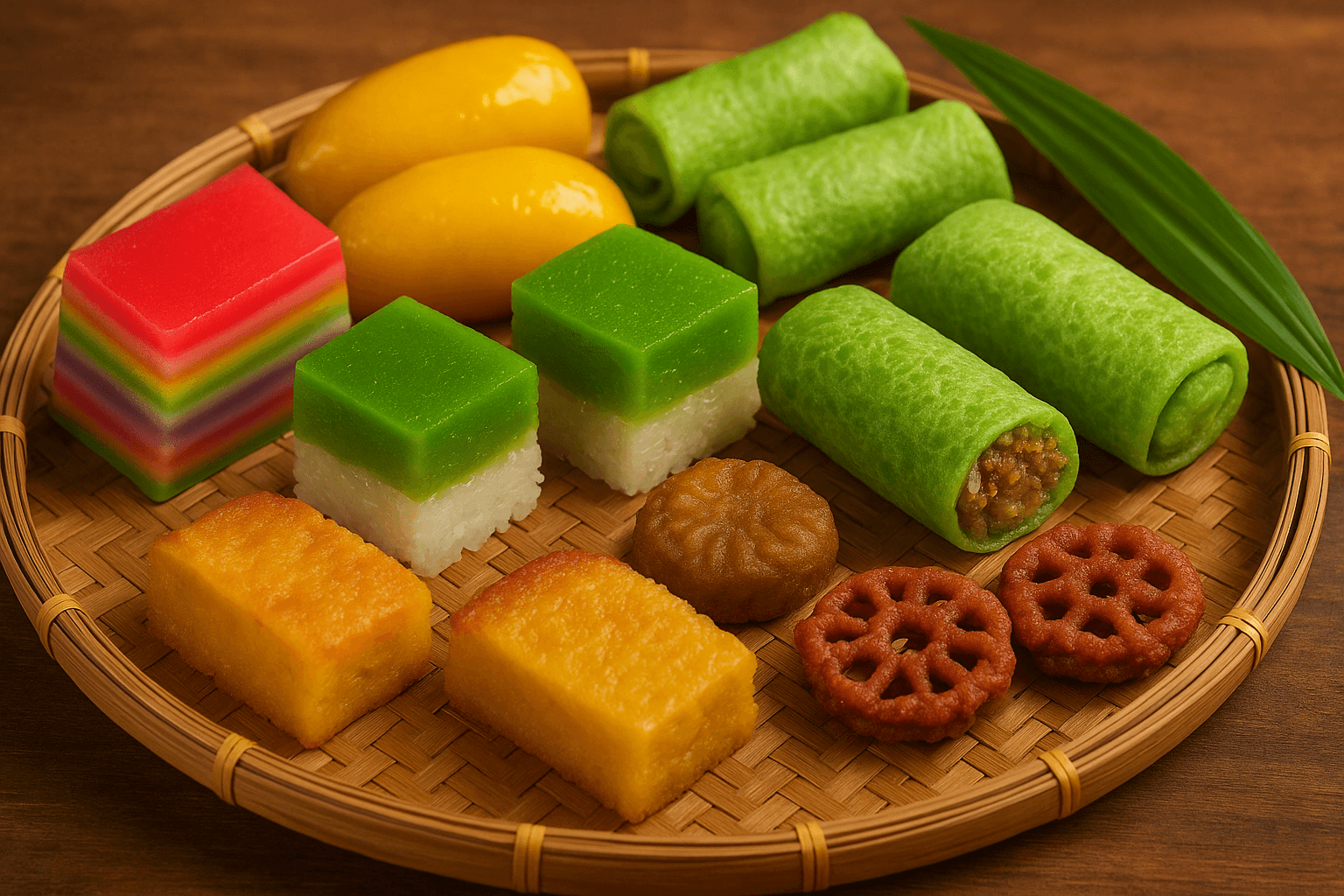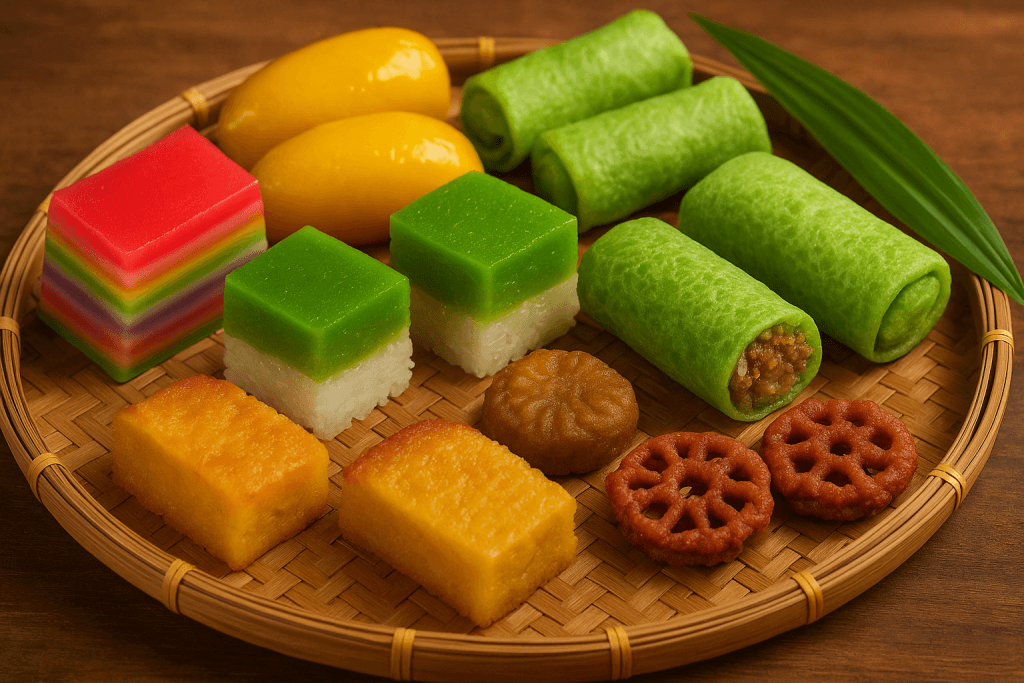Brunei, a small yet culturally rich nation on the island of Borneo, is known not only for its lush rainforests and Islamic heritage but also for its colorful culinary traditions. Among its most cherished gastronomic treasures are the delightful treats collectively known as Kueh in Brunei: Sweet Bites of Heritage and Flavor. These small confections, often vibrant in color and diverse in taste, reflect centuries of cultural exchange, royal influence, and community traditions.
From the morning markets of Bandar Seri Begawan to festive celebrations in villages, kueh occupies a central role in the country’s food culture. Each sweet bite carries a story of tradition, craftsmanship, and identity, making Kueh in Brunei: Sweet Bites of Heritage and Flavor more than just food—it is edible heritage.

The Origins of Kueh in Brunei
The history of Kueh in Brunei: Sweet Bites of Heritage and Flavor is deeply tied to the Malay Archipelago. Influences from Malay, Javanese, Chinese, and Indian communities shaped the flavors and preparation techniques. Coconut milk, palm sugar, rice flour, pandan leaves, and tapioca became the core ingredients that defined the essence of kueh.
These desserts were originally made for religious events, weddings, and community gatherings. Over time, they transitioned into daily indulgences enjoyed with tea or coffee, showcasing how tradition blends seamlessly with modern living.
Symbolism Behind Kueh
In Bruneian culture, Kueh in Brunei: Sweet Bites of Heritage and Flavor symbolizes more than taste. Each piece is carefully crafted to represent abundance, joy, and sharing. Bright colors such as green, pink, and yellow reflect happiness and prosperity, while soft textures symbolize harmony in community.
During Hari Raya Aidilfitri, weddings, or royal events, platters of kueh are presented as gestures of goodwill. Thus, enjoying these sweets connects not only to flavor but also to cultural values of togetherness and respect.
Ingredients That Define Kueh in Brunei
The ingredients in Kueh in Brunei: Sweet Bites of Heritage and Flavor are simple, yet they create extraordinary results:
Coconut Milk: Provides creaminess and richness.
Palm Sugar (Gula Melaka): Adds depth and caramel-like sweetness.
Rice and Tapioca Flour: Build structure and chewy textures.
Pandan Leaves: Contribute fragrance and a signature green hue.
Bananas, Jackfruit, and Durian: Bring tropical fruit notes into selected varieties.
These ingredients highlight Brunei’s tropical abundance and connection to Southeast Asian food traditions.
Popular Varieties of Kueh in Brunei
1. Kueh Lapis
A steamed layer cake made from rice flour and coconut milk, colored in rainbow shades. Each layer peels apart easily, making it a favorite among children and adults alike.
2. Kueh Seri Muka
A two-layered treat with glutinous rice on the bottom and a pandan-coconut custard on top. It is admired for its balance of sweet and savory flavors.
3. Kueh Ketayap
Thin pandan crepes filled with grated coconut and palm sugar. Rolled like a cigar, they are soft, fragrant, and perfectly sweet.
4. Kueh Bingka
Baked tapioca cake with a dense, chewy texture. This variety often appears during festive seasons.
5. Kueh Cincin
A crunchy, deep-fried kueh shaped like small rings. It is less soft and more crispy compared to others, showcasing the variety of textures within Brunei’s kueh culture.
6. Kueh Dadar
A pandan pancake rolled with sweet coconut filling, similar to ketayap but often smaller in size and more intensely flavored.
Each of these treats plays a unique role in preserving the culinary identity of Brunei.
Kueh in Daily Bruneian Life
The presence of Kueh in Brunei: Sweet Bites of Heritage and Flavor is not limited to festivals. Morning markets, known as “tamu,” are vibrant with stalls offering colorful trays of kueh. Workers grab them for breakfast, children enjoy them after school, and families serve them during gatherings.
This accessibility has kept kueh relevant in modern society, proving that heritage foods adapt without losing authenticity.
The Role of Kueh in Brunei’s Festivals
Hari Raya Aidilfitri: Homes are filled with kueh varieties, each host competing to present the most attractive trays.
Weddings: Kueh symbolizes prosperity and fertility, offered to guests as part of traditional rituals.
Royal Events: Some varieties are elevated to ceremonial status, connecting culinary traditions to Brunei’s royal identity.
Through these occasions, Kueh in Brunei: Sweet Bites of Heritage and Flavor remains deeply tied to social and cultural celebration.
Regional and Neighboring Influences
Brunei shares culinary roots with Malaysia and Indonesia, and this is evident in its kueh varieties. However, Brunei’s emphasis on presentation and the royal family’s influence have given its sweets a distinct identity. Certain varieties are richer, more delicately made, and tied to local customs that distinguish them from regional counterparts.
Kueh as a Culinary Heritage
UNESCO has increasingly recognized food as intangible cultural heritage. Although Brunei’s kueh is not officially listed, its importance to cultural preservation is undeniable. Families pass down recipes orally, and community cooking ensures these sweets remain alive for future generations.
Kueh in Brunei: Sweet Bites of Heritage and Flavor thus serves as a living archive of Bruneian history, resilience, and artistry.
Modern Innovations
While traditional recipes remain central, modern Bruneian chefs experiment with flavors and presentation. Chocolate fillings, modern packaging, and contemporary serving styles attract younger generations. Yet, the heart of kueh remains unchanged: simplicity and authenticity.
Cafés across Bandar Seri Begawan now serve fusion versions, proving how Kueh in Brunei: Sweet Bites of Heritage and Flavor evolves without losing tradition.
The Experience of Eating Kueh
Eating kueh is a sensory journey. The soft chew of glutinous rice, the fragrance of pandan, the sweetness of palm sugar, and the richness of coconut milk create a multi-layered experience. Each bite resonates with nostalgia, connecting present generations to ancestors who cherished the same flavors centuries ago.
Preserving Kueh for the Future
As globalization shifts food trends, Bruneians emphasize the importance of safeguarding kueh traditions. Community cooking workshops, government food festivals, and school programs ensure that Kueh in Brunei: Sweet Bites of Heritage and Flavor continues to be celebrated by younger generations.
Preservation efforts also include documentation of recipes, culinary storytelling, and integrating kueh into tourism experiences.
Conclusion
Brunei’s kueh are not merely desserts. They are cultural expressions, family traditions, and historical treasures wrapped in sweet, colorful packages. To taste Kueh in Brunei: Sweet Bites of Heritage and Flavor is to embrace a nation’s soul—one bite at a time.
By celebrating these sweet delicacies, Brunei safeguards its heritage, supports its communities, and shares a flavorful legacy with the world.

